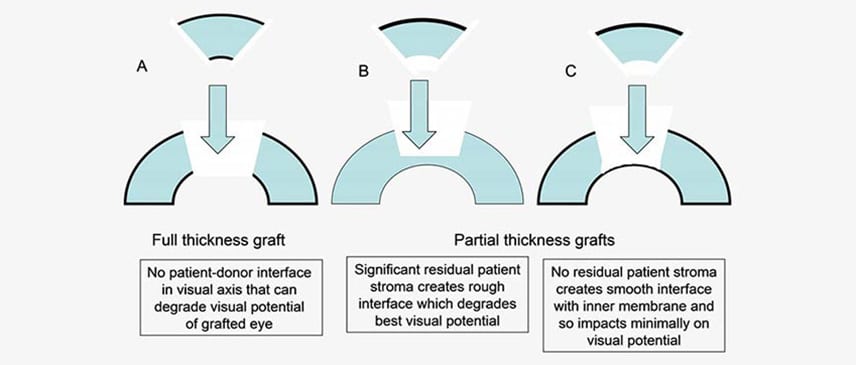

27 Sep DALK
What is DALK, ALTK or FALK?
Replacement of front layers of cornea by similar layers of donor cornea which are prepared by manual, automated or femtosecond laser technique is DALK, ALTK or FALK respectively. The depth of the corneal layers affected in the diseased eye can help determine which procedure can be best for that cornea.
Who can undergo DALK?
Any person with following conditions in the affected eye can undergo DALK.
- Scarring of cornea (white corneal patch)
- Hereditary corneal dystrophy affection front layers of cornea.
- Keratoconus
- Infections of cornea
Requirements prior to operation?
- Consultation with an eye, preferably a cornea doctor.
- Investigations like OCT of cornea to detect depth of scar or corneal condition, which will help in deciding DALK or ALTK.
- Registration with an eye bank can be done once the procedure is finalized.
- Registration with an eye bank.
How is DALK performed?
- First the patient is taken in operation theater, local or general anesthesia given. Eye cleaned and prepared for operation.
- The affected cornea is slit open and the affected layers of the cornea are removed layer by layer or by air separation till the last layer i.e. descemet’s membrane is reached.
- Then the donor cornea is prepared by removing last layer that is descemet’s membrane with endothelial and placed on the recipient eye and secured to it with the help of multiple stitches.
- An eye patch is applied at the end of the operation.
- The entire procedure may take 1-2 hours.
How is anterior lamellar corneal transplant performed?
- Procedure is usually under local or drops anesthesia.
- The affected layers from the cornea of the diseased eye are separated and removed by Femtosecond laser or microkeratome .
- Donor cornea is similarly separated by laser or microkeratome blade,and placed on the affected cornea and secured either without(Stitchless) or with stitches.A Bandage or contact lens placed at the end of the procedure.
What is the advantage over Full thickness corneal transplant?
This procedure has almost negligible chance of rejection and hence does not tend to fail like full thickness corneal transplants.
What is the follow up?
- Immediate-Every week for first month, every 2 months for 1 year, then every 6 months for 2 year, then yearly till all the stitches are removed.
- Immediately after the operation, patient can walk out on his own to the recovery room where he may spend some time. Patient can then be discharged same day and patch can be removed after 24 hours. There may be redness, irritation and blurred vision which usually improve over the next few days similar to full thickness corneal transplant.
- Glasses can be prescribed earliest at 3 months while contact lenses can be given at approximate 6 months after the operation. The vision may continue to improve over next whole year where sutures can be removed selectively so as to bring down the number of glasses especially cylindrical power.
What are the precautions after DALK or ALTK?
The precautions are universal to full thickness corneal grafts. Additionally,No rubbing of the eyes as it can cause loss of graft especially after stitchless ALTK.
What are the complications of DALK?
- Tearing of the delicate descemet’s membrane may occur. This may result in leaking of fluid from inside the eye causing the grafted cornea to be waterlogged. It may heal on its own or may need additional surgery. Sometimes a full thickness graft may be done if the tearing of layer is noticed earlier during the procedure.
- The stitches may become loose over next few months to years causing irritation. Other than that, infection, bleeding and raised eye pressure are other risks too.


Sorry, the comment form is closed at this time.